Adromischus umbraticola
Adromischus umbraticola C.A.Sm. subsp. umbraticola
Family: Crassulaceae
Common names: cliff adromischus (Eng); krans-brosplakkie (Afr)
Introduction
Adromischus umbraticola is a fast-growing, tufted, dwarf, succulent shrub, with attractive rounded leaves and short spikes of pink flowers in late summer. It grows about 30 cm tall and makes a rewarding pot plant that can be kept inside. It grows on rocky ridges and is becoming rare as the urban areas in Gauteng grow.
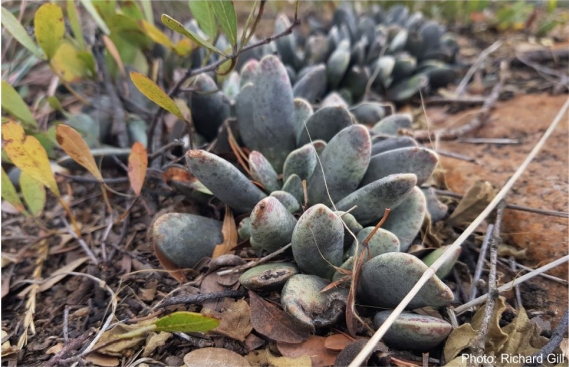
Description
Description
Adromischus umbraticola is a sparingly branched, leaf succulent arising from a tuberous base with 120 mm long fibrous roots. The leaves are oblanceolate to obovate and are slightly crisped when young and smooth when old, with a leaf colour that is light green, purple-infused towards the apex, and covered with purplish spots. The inflorescence is a spike-like thyrse, with 1-flowered cymes, that grows up to 400 mm long, producing small, purplish pink flowers with a greyish-white bloom, in late summer.
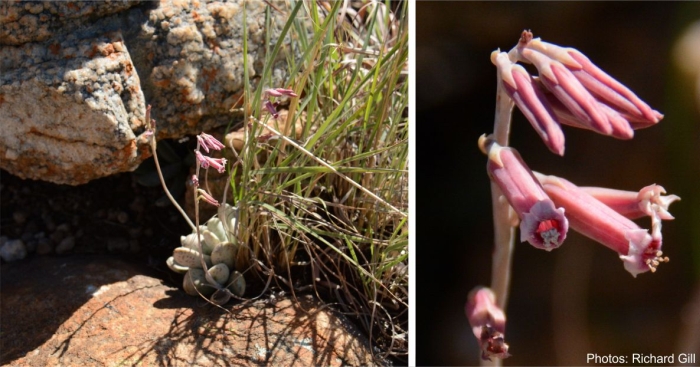
Conservation Status
Status
According to the Red List of South African plants, Adromischus umbraticola is assessed as Near Threated (NT) because its habitat is being affected by urban expansion and land use development.
Distribution and habitat
Distribution description
Adromischus umbraticola is endemic to South Africa, occurring in Gauteng and North West Province. This attractive succulent grows in rock crevices on south-facing rocky outcrops in grassland, on sandy loam soil with a sunny to semi-shaded position. It occurs in Gold Reef Mountain Bushveld and Andesite Mountain Bushveld.
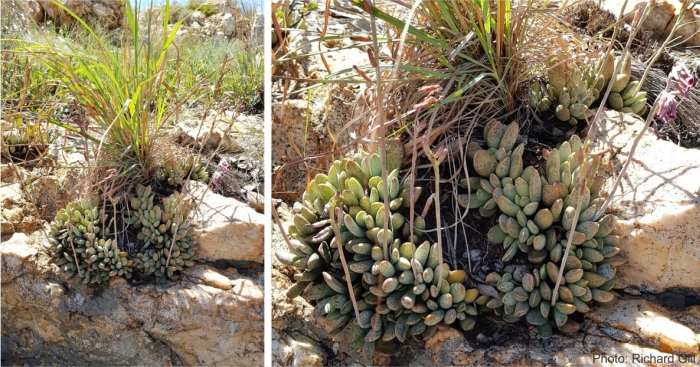
Derivation of name and historical aspects
History
The species Adromischus umbraticola was first described and named in 1933 by Christo Albertyn Smith, from a plant collected at Silkaatsnek in the Magaliesberg, North West, South Africa. The species name is Latin and means ‘shade-lover’.
The genus Adromischus has approximately 40 species, all small, clumping, thick stemmed succulents, native to South Africa and Namibia. The name comes from the ancient Greek adros, meaning ‘thick’ and mischus, meaning ‘stem’. The genus was described in 1852 by Charles Antoine Lemaire. It belongs in the Crassulaceae (stonecrop family) and is a close relative of the tackies, kerky bushes and beestebal plants of the genus Crassula, the plakkies and pig’s ears of the genus Cotyledon, the krimpsiektebossies of the genus Kalanchoe and the botterboom and nentas of the genus Tylecodon.
Ecology
Ecology
Adromischus umbraticola plants in their natural habitat prefer a sunny or semi-shaded position on dry soil and can tolerate temperatures down to -7°c. The flowers are mostly pollinated by small insects.
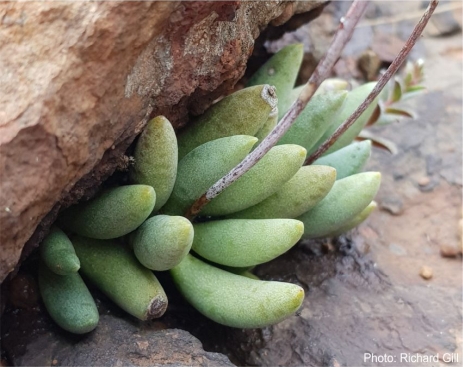
Uses
Use
Adromischus umbraticola has no medicinal or cultural properties but has horticultural value as they are rewarding, long-lived ornamental plants that can be given as gift plants, and make ideal potted plants. They can be kept indoors but they need a lot of light from the window, they will thrive with little care.
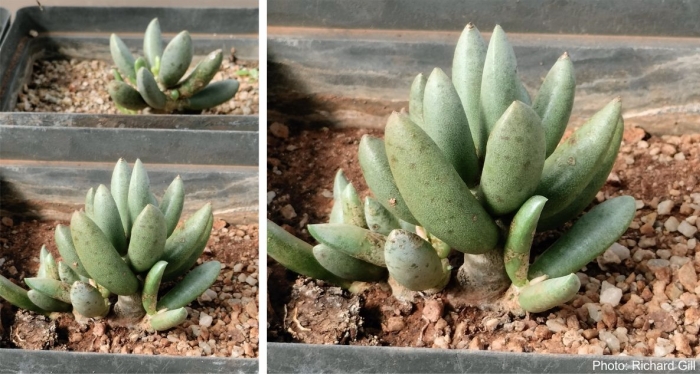
Growing Adromischus umbraticola
Grow
Adromischus umbraticola is one of the easiest species to propagate using leaf cuttings. During its summer growing season, use a clean, disinfected knife to select leaves from a healthy plant. Place the cuttings in a tray filled with well-drained soil, such as sandy soil or gritty loam substrate, with the cut base of the leaf in the soil. Place the trays indoors, where they will receive bright light but not direct sun and water every two weeks in summer. Within approximately a week or two they will be rooted and ready to be potted up.
Plants are easily cultivated in small containers kept indoors and can also be grown outside. They need a sunny or semi-shaded position, in well-drained soil and are ideal for rockeries. They are moderately frost-hardy. Take care not to overwater.
When grown outside, they are often attacked by plant lice (Aphids), caused by over-watering or rain falling in winter. The plant lice usually go for inflorescences, and one should pay attention to this and treat them by squirting soapy water onto the plant to deter plant lice.
References
- Giromagi cactus and succulents, Adromischus umbraticola. https://www.giromagicactusandsucculents.com/adromischus-umbraticola-giromagi-cactus-succulents/. Accessed 03/06/22.
- Helme, N.A. & Raimondo, D. 2006. Adromischus umbraticola C.A.Sm. subsp. Umbraticola. National Assessment: Red List of South African Plants version 2022.1. Accessed on 2022/06/03
- Rodgerson, C. & Cocozza, J. 1994. Adromischus. British Cactus & Succulent Society. Vol. 12: No.2
- Smith, G.F., Crouch, N.R. & Figueiredo, E. 2017. Field guide to succulents in southern Africa. Struik Nature, Cape Town.
- Smith, G.F., Crouch, N.R. & Oosthuizen, D. 2019. Notes on Adromischus umbraticola C.A.Sm. subsp. umbraticola and A. umbraticola subsp. ramosus Toelken (Crassulaceae). Bradleya 37: 218-225
- The Phyto-philes: Adromischus umbraticola, post by Willem published in 2013 on h2g2. https://h2g2.com/entry/A87820086.
- Van Jaarsveld, E.J. 2010. Waterwise gardening in South Africa and Namibia. Struik, Cape Town.
- Van Wyk, B. & Malan, S. 1998. Field guide to the wild flowers of the Highveld. Struik, Cape Town.
- Whitaker’s Words Online, search for umbraticola. https://latin-words.com/.
Credits
Caroline Marima
Pretoria National Botanical Garden, Groen Sebenza Horticulturist Intern
July 2022
Acknowledgements: the author thanks Richard Gill for providing images of the plant.
Plant Attributes:
Plant Type: Succulent
SA Distribution: Gauteng, North West
Soil type: Loam
Flowering season: Late Summer
PH: Acid, Neutral
Flower colour: Purple, Pink
Aspect: Shade, Morning Sun (Semi Shade), Afternoon Sun (Semi Shade)
Gardening skill: Easy
Special Features:
Horticultural zones








Rate this article
Article well written and informative
Rate this plant
Is this an interesting plant?
Login to add your Comment
Back to topNot registered yet? Click here to register.